Fair Start Scotland - evaluation report 3: participant phone survey - year 2
Part of a series of reports on the evaluation of Fair Start Scotland (FSS) employability services. It presents more detailed findings from a representative telephone survey of FSS participants and explores their experiences in the second year of service delivery (April 2019 to March 2020).
4. Employment outcomes
The first part of this section examines the employment status of FSS participants[14], beginning with the 2019 cohort and moving on to look at the 2018 cohort and how their employment status has changed between the Wave 1 and Wave 2 surveys. The impact of the coronavirus pandemic on employment will also be explored. It should also be noted that, for the majority of people joining FSS, not enough time has elapsed to allow for assessment of sustained employment job outcomes.
The second part of the section describes the quality of work that both the 2019 and 2018 cohort have moved into, including their job role, pay and contract type.
Employment status of the 2019 cohort
At the time of the survey, just under one third (31 per cent) of the 2019 cohort were either working for an employer or self-employed, see Figure 4.1, with a further four per cent having worked at some point in the last week. This total of 35 per cent is higher than the equivalent proportion of 2018 participants that were in work at the point of the Wave 1 interview (in June 2019), which was 29 per cent.
The majority were not in work however, with over half (53 per cent) claiming an out-of-work benefit, and one in twenty (five per cent) in education, as shown in Figure 4.1. Of those that were not working, four percent said that they do undertake some paid work in a typical week.
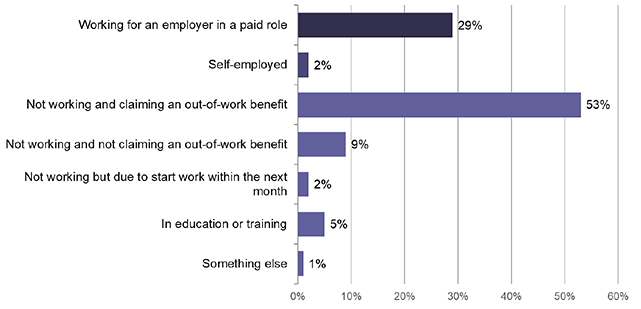
Image description:
This figure shows employment status for the 2019 cohort. 29% were working for an employer in a paid role and 2% were self-employed. Additionally, 53% were not working and claiming an out of work benefit. 9% were not working and not claiming, 5% were in education or training, 2% were not working but due to start within the next month and 1% said something else.
Source: IFF Research telephone survey of FSS customers. A1_W2. Which of the following best describes what you are doing at the moment? Base: 2019 cohort (607) A1A_W2. In a typical week do you do any paid work, either as an employee or self-employed? Base: 2019 cohort, all other than employed and self-employed (427)
Of the group that was in work, almost half (46 per cent) started their role less than six months ago, with over four fifths (83 per cent) having started work within the last year (June 2019 or later). Figure 4.2 shows that over half (54 per cent) were working for 30 or more hours per week, with a further third (30 per cent) working between 16 and 29 hours a week. Men were more likely to work 30 or more hours a week (60 per cent) than women (44 per cent).

Image description:
This figure shows the hours worked per week by the 2019 cohort. 54% of those in work worked 30 or more hours, 30% 16 to 29 hours and 16% fewer than 16 hours."
Source: IFF Research telephone survey of FSS customers. A3_W2. How many hours per week do you usually work, or spend in education? Base: 2019 cohort in work (195)
There were several factors that affected participants' likelihood of being in work at the time of the survey:
- Previous employment history was the clearest driver of current employment status, with those who had done some form of work in the last five years much more likely to be in work (45 per cent) than those who had not (nine per cent in work).
- Participants limited by a long-term health condition were more likely to be out of work (67 per cent), compared to those with no condition (50 per cent not in work).
- Age was also an important factor in determining employment status. Those aged 25-34 were more likely to be in work (43 per cent), while those aged 35-49 were less likely to be in work (27 per cent) than the other age groups. Those over 50 were less likely to be in education or training (one per cent) and more likely to be claiming an out of work benefit (60 per cent). As might be expected, the youngest group (16-24) were most likely to be doing something else (11 per cent) such as education or volunteering.
- Education also had an impact, with those with a degree level qualification or higher more likely to be in work (46 per cent, compared with 34 per cent average).
- There were some differences in employment status by geographical area. Participants in Lot 3 - Tayside more likely to be in work (62 per cent), compared to other areas, while those in Lot 5 - East were less likely to be in work (21 per cent).
In terms of the forms of work undertaken, women were more likely than men to be working for an employer in a paid role (34 per cent, compared with 26 per cent), and men were more likely than women to be claiming an out of work benefit (58 per cent, compared with 43 per cent). Those in priority families were more likely to be self-employed (six per cent) than those not in priority families (one per cent).
Employment status of the 2018 cohort
At the time of the Wave 2 survey, over a third (36 per cent) of the 2018 cohort were either working for an employer, self-employed or did some paid work in a typical week. The majority were not in work however, with over half (55 per cent) claiming an out-of-work benefit, and one in twenty (four per cent) in education, as shown in Figure 4.3 below.
Over two fifths (44 per cent) of this cohort started their job over a year ago, with almost three quarters (74 per cent) having started at least six months ago. This indicates that those entering work are managing to sustain it over time.
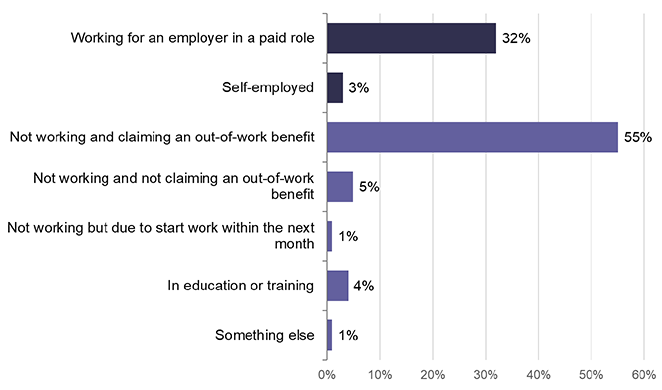
Image description:
This figure shows employment status for the 2018 cohort. 32% were working for an employer in a paid role and 3% were self-employed. Additionally, 55% were not working and claiming an out of work benefit. 5% were not working and not claiming, 4% were in education or training, 1% were not working but due to start within the next month and 1% said something else.
Source: IFF Research telephone survey of FSS customers. A1_W2. Which of the following best describes what you are doing at the moment? Base: 2018 cohort (400) A1A_W2. In a typical week do you do any paid work, either as an employee or self-employed? Base: 2018 cohort, all other than employed and self-employed (262)
Again, there were various factors that affected the likelihood of 2018 participants being in employment at the wave 2 survey. The strongest driver appeared to be qualifications. Those with Highers or Advanced Highers were more likely to be working (52%) than average (36%) and those with no qualifications were more likely to be out of work (77%) than average (59%).
The youngest age group, 16-24, were more likely to be in work (51 per cent) than other ages, and women were more likely to be in education or training than men (8 per cent compared with one per cent). Furthermore, priority families were less likely to be out of work claiming benefits than those not in a priority family group (41 per cent, compared with 58 per cent).
Figure 4.4 shows that almost half (47 per cent) of those in work were working for 30 or more hours per week, while 15 per cent were on fewer than 16 hours per week. Men were more likely than women to be in work more than 30 hours per week (55 per cent compared with 35 per cent).

Image description:
This figure shows the hours worked per week for the 2018 cohort. 47% worked 30 or more hours, 38% 16 to 29 hours and 15% fewer than 16 hours.
Source: IFF Research telephone survey of FSS customers. A3_W2. How many hours per week do you usually work, or spend in education? Base: 2018 cohort in work (146)
Change in employment status over time
The 2018 cohort joined the FSS service between March and December 2018. A proportion of this cohort were surveyed in both June 2019 and May 2020, allowing us to track their employment status over time.
Figure 4.5 shows that the majority of the 2018 cohort were not in work at either Wave 1 or Wave 2 (64 per cent). However, more than one in ten (12 per cent) had moved into work between waves, while only five per cent moved out of work. Around one in five (19 per cent) remained in work throughout both waves.
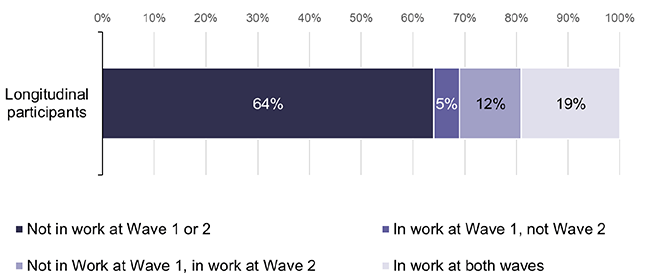
Image description:
This figure shows changes in work status between June 2019 and May 2020 for the 2018 cohort. 64% were not in work at Wave 1 or 2, 5% were in work at Wave 1, but not Wave 2, 12% were in work at Wave 2, but not Wave 1, and 19% were in work both Waves.
Source: IFF Research telephone survey of FSS customers. A1_W1 and A1_W2. Which of the following best describes what you are doing at the moment? Base: 2018 cohort other than refused (386)
Participants were also asked about their employment status for the year between the Wave 1 and Wave 2 survey. As shown in Figure 4.6, the majority (64 per cent) reported that their employment situation had stayed the same between waves. One in six (16 per cent) were mostly in work (either employment or self-employment), while one in ten (11 per cent) were mostly out of work. Around two-thirds of those that said their situation had stayed the same were not working and claiming an out-of-work benefit (64%). A further quarter were working for an employer in a paid role (26%).
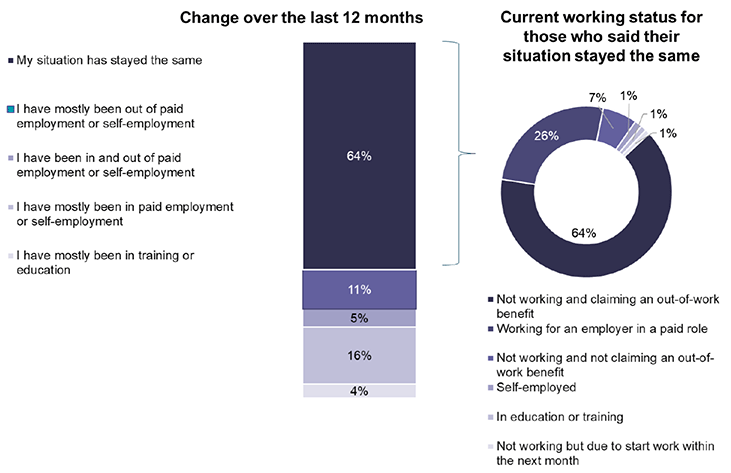
Image description:
This figure shows employment status since the Wave 1 survey for the 2018 cohort. Over the last 12 months, 64% said their situation had stayed the same, 16% had mostly been in paid employment or self-employment, 11% mostly out of paid employment or self-employment, 5% in and out of employment or self-employment and 4% mostly in training or education.
Source: IFF Research telephone survey of FSS customers. B1A_W2. Which of the following best describes what you've been doing since the last survey? Base: 2018 cohort other than refused (399) Base: 2018 cohort that said their situation had stayed the same (255)
Impact of Coronavirus
All participants were asked whether and how the Coronavirus outbreak had impacted their employment status. Four in five (79 per cent) had seen no impact on their employment status at the time of the survey in May 2020. Of those that were affected, as shown in Figure 4.7, four in ten had left employment (31 per cent) or education/training (9 per cent). A further four in ten (39 per cent) were in employment but had been put on furlough, and a further nine per cent reported that their work had been affected in another way, such as increased hours or working from home. One in twenty (5 per cent) were working reduced hours. Those in the other category (9%) included participants who were forced to isolate or were on sick pay.
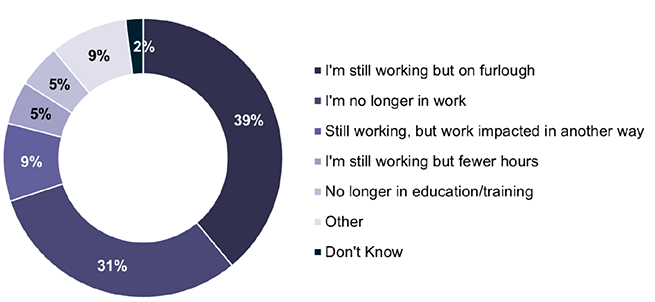
Image description:
This figure shows the impact of coronavirus on employment status for those who said they were affected by the outbreak from both cohorts. Most commonly, respondents were still working but on furlough (39%), followed by no longer working (31%), still working, but impact in another way (9%), still working but fewer hours (5%) and no longer in education or training (5%).
Source: IFF Research telephone survey of FSS customers. A1b_W2 And has your employment status changed at all as a result of the Coronavirus outbreak? & A1c_W2. What is your employment situation at the moment? Base: All participants affected by outbreak (210)
Quality of work
The Wave 2 survey asked participants about their job roles, how much they earned and the type of contract they were employed on. These questions were new at Wave 2 and asked of all participants (across the 2018 and 2019 cohorts) who were employed at the time of the survey.
Occupation
Around one third (35 percent) of participants were currently employed, self-employed, or had done some work in the week before the Wave 2 survey. These participants were asked about their job title and their duties in the role, these answers were coded into job role descriptions and occupations.[15]
Figure 4.8 shows the profile of working participants by occupation. They are ordered based on the ONS hierarchy which moves from highly skilled professions at the top, to less skilled professions at the bottom. Similarly, they are colour coded based on the broad occupation groups they fall into.
The most common grouping was elementary occupations, representing four in ten (41 percent) participants who had worked in the last week. Following that, 16 per cent worked in sales and customer service occupations. Around one in ten worked in caring leisure and other service occupations (12 per cent), process plant and machine operatives (9 per cent) and administrative and secretarial occupations (9 per cent). No participants worked in the following occupational groups: Corporate Managers and Directors; Science, Research, Engineering and Technology Professionals; Health Professionals; Protective Service Operations all of which fall into the top three major groups recognised by the ONS as requiring the most skills.
This means that half (50 per cent) of working FSS participants were in labour intensive occupations, almost three in ten (28 per cent) were working in service intensive occupations, 15 per cent were working in middle skill occupations and just over one in twenty (7 per cent) worked in high skill occupations.
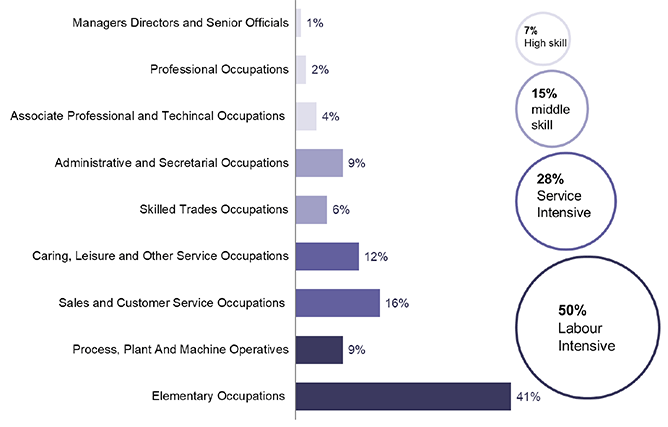
Image description:
This figure shows the occupational profile of participants in work during the week of the Wave 2 survey for both cohorts. 41% were in elementary occupations, 16% sales and customer service, 12% caring, leisure and other service occupations, 9% process, plant and machine operatives, 9% administrative and secretarial occupations, 6% skilled trades, 4% associate professional and technical and 1% managers, directors and senior officials. To summarise, 50% were in labour intensive roles, 24% in service intensive roles, 15% middle-skilled and 7% highly skilled.
Source: IFF Research telephone survey of FSS customers. Taken from collating and coding answers from A5: What is/was your job title? And A6: What do/did you mainly do in your job? Base: 2019 cohort that were employed, self-employed or had worked in the last week (341).
Income from employment
Participants that were employed, self-employed or had worked in the last week were asked about their usual pay, including overtime, bonuses or tips, but before tax and other deductions were taken out.
Figure 4.9 shows that, of those participants that had worked in the last week, three in ten earned the national minimum wage or below (30 per cent).[16] Around six in ten (61 per cent) earned above the national living wage, the majority of whom earned £8.22 to £9.30 an hour (36 per cent) or £9.30-£15.00 (22 per cent). A small minority earned above £15.01 an hour (3 per cent)[17].
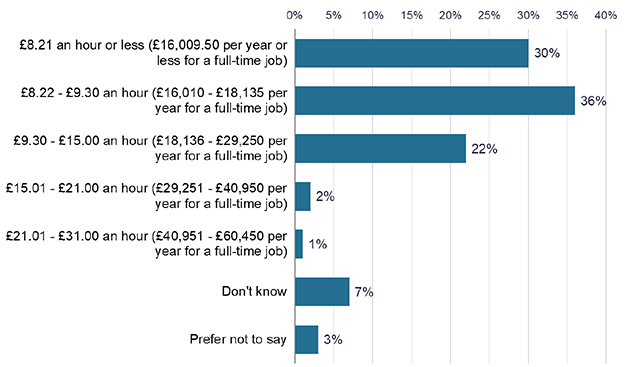
Image description:
This chart shows the usual income of participants in work during the week of the Wave 2 survey for both cohorts. Most commonly participants received 8.22 to 9.30 per hour or 16,010 to 18,135 per year (36%), followed by 8.21 an hour or 16,009.50 per year or less (30%). 20% received 9.30 to 15 an hour or 18,136 to 29,250 per year.
Source: IFF Research telephone survey of FSS customers, A7: Can you tell me your usual pay including overtime, bonuses, or tips (but before tax and other deductions are taken out)? Base: All employed self-employed or had worked in the last week (341)
Types of employment contract
Participants who were working or had worked in the last week were asked what type of employment contract they held. Figure 4.10 shows that over half of this group were employed on a permanent contract (56 per cent). Around one quarter were employed on a temporary employment contract (23 per cent) with a further (10 per cent) employed on zero hours contracts. One in twenty were self-employed per cent (6 per cent).
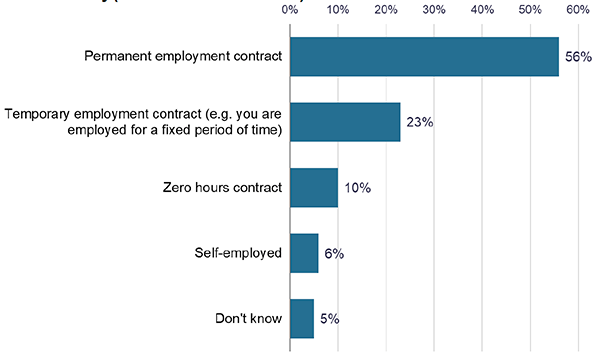
Image description:
This figure shows the type of employment contract of participants in work during the week of the Wave 2 survey for both cohorts. 56% were on a permanent contract, 23% temporary, 10% zero-hours, 6% self-employed and 5% did not know.
Source: IFF Research telephone survey of FSS customers, A8: Can you tell me what type of employment contract you have? Base: All employed, self-employed or have worked in the last week (341)
There were some participant sub-groups that were more likely to be employed on a permanent contract than other groups. These included female participants (67 per cent compared to 51 per cent of male participants), and white participants (59 per cent, compared to 39 per cent of minority ethnic participants). In addition, individuals in priority families were more likely to be self-employed than those not part of the priority family groups (15 per cent, compared to 4 per cent).
Contact
Email: socialresearch@gov.scot
There is a problem
Thanks for your feedback